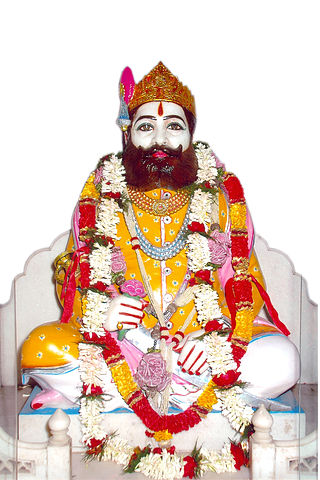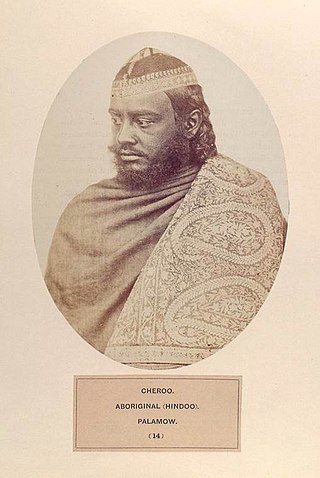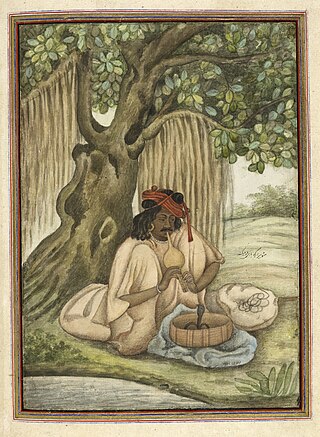 Photo of a Gangaputra Brahmin in 1875, J Forbes Watson | |
| Regions with significant populations | |
|---|---|
| Religion | |
| | |
| Related ethnic groups | |

The Gangaputra Brahman are a Hindu Brahmin community, found in the state of Uttar Pradesh in India. [1] [2]
 Photo of a Gangaputra Brahmin in 1875, J Forbes Watson | |
| Regions with significant populations | |
|---|---|
| Religion | |
| | |
| Related ethnic groups | |

The Gangaputra Brahman are a Hindu Brahmin community, found in the state of Uttar Pradesh in India. [1] [2]
The community is an offshoot of the Kanyakubja Brahmins. Gangaputra in Sanskrit signifies sons of the Ganges river. [3] [4] The Gangaputra are associated with the river Ganges, and their communities are located mainly along the banks of the river. These people were also known as the Ghatiya, because they occupied the piers of the Ganges; ghat in Hindi signifies pier. [5]
The Gangaputra Brahmin are found mainly in the Farrukhabad, Kanpur and Shahjahanpur districts. Their main occupation is to officiate at the various holy occasions which occur along the river. [6]
The Belwar are a Hindu sanadhya Brahmin caste found in North India, and mostly in Uttar Pradesh. Sanadhya Brahmins are called Belwars in mainly Sitapur, Lakhimpur, Hardoi, Barabanki, Gonda and Lucknow. The like to be called Bilwar or Bailwar as it is a matter of pride for them.

Nomads are known as a group of communities who travel from place to place for their livelihood. Some are salt traders, fortune-tellers, conjurers, ayurvedic healers, jugglers, acrobats, actors, storytellers, snake charmers, animal doctors, tattooists, grindstone makers, or basketmakers. Some anthropologists have identified about 8 nomadic groups in India, numbering perhaps 1 million people—around 0.12 percent of the country's billion-plus population. Aparna Rao and Michael Casimir estimated that nomads make up around 7% of the population of India.

Agrahari, Agraharee or Agarhari is an Indian Vaishya community, They are the descendants of legendary king Agrasena. Predominantly, they are found in the Indian state of Uttar Pradesh, Madhya Pradesh, Jharkhand, Chhattisgarh and Terai region of Nepal.
The demographics of Uttar Pradesh is a complex topic, which is undergoing dynamic change. Uttar Pradesh is India's most populous state, and the largest subdivision in the world. It has a population of about 199,812,341 as per the 2011 census. If it were a separate country, Uttar Pradesh would be the world's fifth most populous nation, next only to China, the rest of India, the United States of America and Indonesia. Uttar Pradesh has a population more than that of Pakistan. There is an average population density of 828 persons per km2 i.e. 2,146 per sq mi. The capital of Uttar Pradesh is Lucknow, and Prayagraj serves as the state’s judicial capital. Hindus and Muslims both consider the state as a holy place.
The Sahariya are a community found in the Bundelkhand region of North India, which is administered by the states of Madhya Pradesh and Uttar Pradesh. They are also known as Rawat, Banrawat, Banrakha and Soarain.
The Ghate Bania are a Hindu caste, found in the state of Uttar Pradesh in India. A few are also found in Haryana state, India. They are sub-caste of the Bania community found throughout North India.

The Chero is a caste found in the states of Bihar, Jharkhand and Uttar Pradesh in India.
The Beldar are a historically nomadic caste, originally from Northern India and now inhabiting many other parts of that country.
The Dhagi are a Hindu caste, found in North India.

The Sapera are a Hindu caste found in North India. They are also known as Barwa Sampheriya in West Bengal, Sapela in Punjab and Sparera in Madhya Pradesh.
The Patharkat are a Hindu caste found in North India. They are also known as Sangtarash.

The Nat are a Hindu caste found in northern India.
The Bharbhunja are an occupational caste found in North India and Maharashtra. They are also known as Kalenra in Maharashtra. A small number are also found in the Terai region of Nepal.
The Barai are a Hindu caste found in Uttar Pradesh, India. The people of this community mainly uses "Chaurasia" as surname.
The Bandhmati are a Hindu caste found in the state of Uttar Pradesh in India. They are also known as Banbasi.

The Boria, also known as Baurasi, are a Hindu caste found in North India.
The Gandhila sometimes pronounced as Gandhil and Gandola, are a Hindu caste found in North India. They have scheduled caste status in Punjab and Haryana.
The Kuta are a Hindu caste found in the state of Uttar Pradesh in India. They are also known as Dhankuta.
The Kuthaliya Bora are a Hindu caste found in the state of Uttarakhand in India. They are also known as Bora Karki.
The Jhamar are a Hindu caste found in the state of Uttar Pradesh in India. They are also known as Jhaunwar.